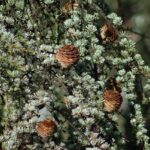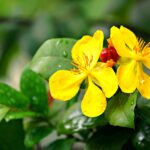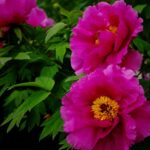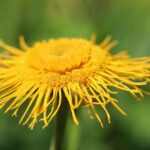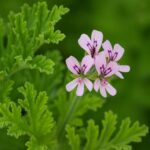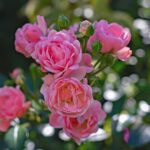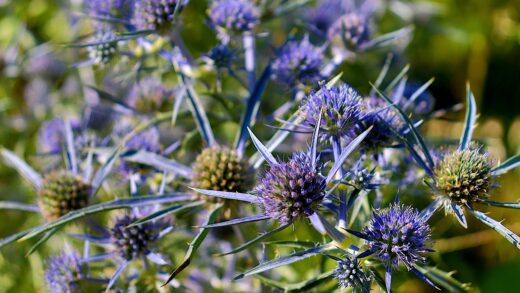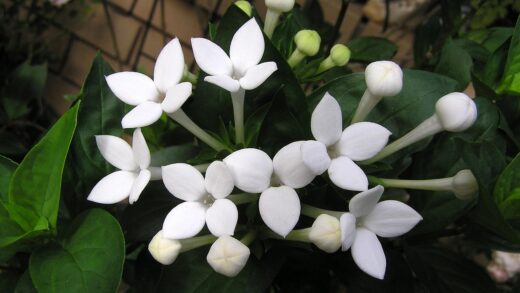One of the most appealing characteristics of Caryopteris for the home gardener is its notable resistance to a wide range of pests and diseases. This hardy shrub is generally a low-maintenance and trouble-free addition to the landscape. Its foliage contains aromatic compounds that are pleasant to humans but act as a natural repellent to many common garden pests, most significantly deer and rabbits, which consistently leave it untouched. This inherent resilience means that in a well-maintained garden, Caryopteris rarely suffers from serious health issues. However, no plant is completely immune, and understanding the few potential problems that can arise is key to keeping it healthy.
The most significant threat to the health and survival of a Caryopteris plant is not an insect or a pathogen in the traditional sense, but rather an environmental condition: poor soil drainage. This shrub is extremely susceptible to root rot if it is planted in heavy, waterlogged soil. Root rot is caused by soil-borne fungi, such as Phytophthora, that thrive in anaerobic (low-oxygen) conditions created by excess water. These pathogens attack the root system, causing it to decay and lose its ability to absorb water and nutrients, leading to the eventual death of the plant. Therefore, prevention through proper site selection and soil preparation is paramount.
In terms of insect pests, Caryopteris is seldom a target. Occasionally, if a plant is stressed due to other factors like drought or poor location, it may become more vulnerable to common sap-sucking insects. Aphids might be found clustered on the tips of new growth, and in hot, dry conditions, spider mites could potentially become an issue, causing a fine stippling or bronzing on the leaves. These infestations are typically minor and do not cause significant harm to an otherwise healthy plant. They can often be managed with simple, non-chemical methods.
Foliar diseases are also uncommon on Caryopteris. The plant’s leaves are not particularly susceptible to the fungal spots or mildews that plague many other garden perennials and shrubs. Good air circulation is a key preventative measure for any potential fungal issues. This can be achieved by giving the plant adequate space to grow without being crowded by other plants and by performing the annual pruning, which maintains an open and airy structure. In essence, providing the right growing conditions is the most effective way to prevent the vast majority of potential pest and disease problems.
Common diseases and prevention
The primary disease concern for Caryopteris is unequivocally root rot. This condition is not caused by a single organism but rather a complex of water-mold fungi that flourish in saturated soils. The symptoms above ground can be deceptive, often mimicking those of drought stress. The plant’s leaves may yellow, wilt, and drop, and the overall growth may be stunted. If these symptoms are observed, it is crucial to inspect the soil moisture. If the soil is consistently wet, root rot is the likely culprit.
More articles on this topic
Preventing root rot is entirely dependent on providing the right growing environment. The single most important factor is excellent drainage. When planting, choose a site that does not have standing water after rain. If the native soil is heavy clay, it must be amended with copious amounts of organic matter like compost or pine bark fines to improve its structure and porosity. Planting Caryopteris on a gentle slope or in a raised bed is an excellent strategy to guarantee that water drains away from the crown and roots. Careful watering practices, allowing the soil to dry out between applications, are also essential.
While far less common, other fungal issues like leaf spot or botrytis (gray mold) can occasionally appear, especially during unusually wet and humid summers. Fungal leaf spots manifest as small, discolored lesions on the foliage but are typically a cosmetic issue and do not threaten the life of the plant. Botrytis might appear on dense, crowded growth where air circulation is poor, causing a fuzzy gray mold to form. The best prevention for these issues is to ensure good air movement around and through the plant.
Proper sanitation can also play a role in disease prevention. Removing any fallen leaf debris from around the base of the plant at the end of the season can help to reduce the overwintering sites for fungal spores. The annual hard pruning in late winter or early spring also serves to remove any potentially diseased wood from the previous season, allowing the plant to start fresh with healthy new growth. In general, chemical fungicides are not necessary for Caryopteris if it is sited and cared for correctly.
Identifying common pests
Caryopteris is prized for its deer and rabbit resistance, a significant advantage in many gardens. However, it is not entirely immune to smaller insect pests, although infestations are infrequent and rarely severe. The most likely culprits are aphids and spider mites. Aphids are small, pear-shaped, soft-bodied insects that use piercing mouthparts to suck sap from tender new growth. They can be of various colors, including green, black, or gray, and often congregate in colonies on shoot tips and the undersides of leaves.
More articles on this topic
Spider mites are another potential pest, particularly in hot, dry climates or during periods of drought. These are not true insects but tiny arachnids that are difficult to see with the naked eye. Their presence is often first detected by the damage they cause: a fine, pale stippling or speckling on the leaves. In heavier infestations, fine webbing may be visible on the undersides of leaves and between stems. A simple test is to hold a white piece of paper under a branch and tap it; if tiny specks fall and start to move, they are likely spider mites.
Occasionally, other generalist garden pests like whiteflies or leafhoppers might visit the plant, but they rarely cause significant damage. Whiteflies are small, moth-like insects that fly up in a cloud when disturbed, while leafhoppers are wedge-shaped, mobile insects that jump or fly away quickly. Both are sap-feeders, but their feeding on a woody shrub like Caryopteris is usually inconsequential to the plant’s overall health. It is important to correctly identify the pest before considering any treatment.
Monitoring plants regularly is the key to catching any potential pest issue early before it becomes a major problem. A quick inspection of the leaves, especially the new growth and the undersides of foliage, can reveal the early signs of an infestation. In most cases, the populations of these pests on a resilient plant like Caryopteris are kept in check by natural predators and do not require intervention. A healthy ecosystem with a diversity of plants will attract beneficial insects like ladybugs, lacewings, and predatory mites that are the best defense against pest outbreaks.
Organic pest management
For the minor pest issues that may occasionally affect Caryopteris, organic and integrated pest management (IPM) strategies are highly effective and are the recommended course of action. The first and simplest method for dealing with pests like aphids is a strong jet of water from a garden hose. This can physically dislodge many of the insects from the plant without the need for any chemical sprays. This process can be repeated every few days until the pest population is under control.
If a water spray is not sufficient, insecticidal soap is an excellent, low-impact option. These soaps are specifically formulated to kill soft-bodied insects like aphids and spider mites on contact while having minimal impact on beneficial insects and the environment. It is crucial to follow the label directions for dilution and application. The spray must make direct contact with the pests to be effective, so thorough coverage, especially on the undersides of leaves, is necessary. Avoid spraying during the heat of the day or in direct sun to prevent leaf scorch.
Encouraging natural predators is a cornerstone of organic pest management. By planting a diverse range of flowering plants, particularly those with small flowers like dill, fennel, and alyssum, you can attract beneficial insects to your garden. Ladybugs, lacewings, and hoverflies are voracious predators of aphids, while predatory mites help to control spider mite populations. Creating a welcoming habitat for these “good bugs” provides a continuous and self-regulating form of pest control that is far more sustainable than relying on pesticides.
For a healthy Caryopteris, the need for any intervention is rare. The plant’s natural defenses, combined with a healthy garden ecosystem, are usually more than sufficient to keep pests at bay. The focus should always be on preventative measures: providing the right growing conditions to ensure a strong, vigorous plant that is less susceptible to attack in the first place. A healthy plant is the best defense against any pest or disease.
The role of plant health
The overall health of a Caryopteris shrub is its primary defense against both diseases and pests. A vigorous, well-cared-for plant is far less likely to succumb to problems than one that is stressed by poor growing conditions. Stress factors can include insufficient sunlight, waterlogged soil, prolonged drought, or nutrient imbalances. These stressors weaken the plant’s natural defense mechanisms, making it an easier target for opportunistic pathogens and pests.
Ensuring the plant receives at least six hours of direct sunlight per day is crucial. Sunlight provides the energy the plant needs for photosynthesis, allowing it to produce the resources required for growth, flowering, and defense. A plant grown in shade will be weaker, leggier, and more susceptible to issues. Similarly, providing excellent soil drainage is non-negotiable. This prevents the primary threat of root rot and ensures the root system is healthy and efficient at absorbing water and nutrients.
Proper pruning also contributes significantly to plant health. The annual hard pruning in late winter or early spring stimulates strong new growth and creates an open, airy structure. This improved air circulation helps the foliage to dry quickly after rain or dew, which greatly reduces the likelihood of fungal diseases taking hold. It also removes any wood that may have been damaged over the winter, preventing it from becoming an entry point for disease.
Ultimately, an integrated approach that focuses on creating an ideal growing environment is the most effective strategy for managing pests and diseases on Caryopteris. By focusing on the fundamentals of plant care—correct siting, proper soil preparation, appropriate watering, and timely pruning—gardeners can ensure their bluebeard shrubs remain robust and healthy. This proactive, holistic approach minimizes the need for reactive treatments and allows the plant’s natural resilience to shine.
📷Agnieszka Kwiecień, Nova, CC BY-SA 4.0, via Wikimedia Commons







